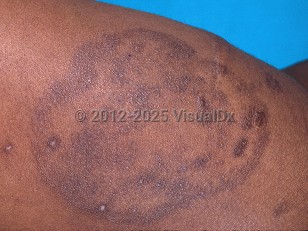Tinea corporis in Child
See also in: Cellulitis DDxAlerts and Notices
Important News & Links
Synopsis

Tinea corporis, also commonly known as "ringworm," is a skin infection caused by a dermatophyte species of fungus, namely of the genera Trichophyton, Microsporum, or Epidermophyton. Fungal organisms are transmitted to humans by direct contact (with animals or with humans, such as in tinea corporis gladiatorum, common in wrestlers), or through fomites. Tinea corporis is more prevalent in warm, humid climates and may also result from the spread of infection from other body sites.
Tinea corporis usually appears as an annular plaque with a scaly, erythematous border. It may be itchy, especially in the case of Trichophyton rubrum infections, in which case, secondary lichenification from scratching may obscure its annular configuration. However, tinea corporis may be minimally pruritic or asymptomatic. It may be a superficial infection or it may affect follicular structures. When tinea infects the follicle, the condition may appear as a fungal folliculitis, or it may appear more deeply situated (deep dermatophytosis). Follicular infection is known as Majocchi granuloma.
Tinea imbricata is a distinct form of tinea corporis caused by Trichophyton concentricum, which is prevalent in tropical locales such as Central and South America, the South Pacific, and Southeast Asia. Tinea indecisiva (tinea pseudoimbricata) is tinea corporis that mimics tinea imbricata. These cases are not caused by Trichophyton concentricum but rather by other Trichophyton or Microsporum species. There is usually underlying immunosuppression in patients with tinea indecisiva.
Trichophyton indotineae is an emerging dermatophyte characterized by extensive or atypical presentations and resistance to topical and oral therapies.
Trichophyton mentagrophytes genotype VII (TMVII) is an emerging strain that is typically spread through close contact, including sexual contact. It may lead to genital and buttock tinea as well as tinea corporis.
In immunocompromised patients, infection can be quite similar to that in immunocompetent patients, with superficial scaly plaques, pruritus, and lesions displaying the classic annular, advancing, scaling border. However, infections without classic features are seen. Disseminated tinea corporis may be seen in patients with immunosuppression, diabetes, Cushing syndrome, and malignancy. Dermatophyte infections are frequently seen in untreated AIDS and solid organ transplant patients. Renal transplant patients are at even higher risk for tinea corporis. Severe tinea capitis and corporis, Majocchi-like granulomas, deep ulcerated fungal infections, and fungal nail involvement occur in an inherited deficiency of CARD9 (caspase recruitment domain-containing protein 9), an inflammatory cascade-associated protein.
Tinea corporis usually appears as an annular plaque with a scaly, erythematous border. It may be itchy, especially in the case of Trichophyton rubrum infections, in which case, secondary lichenification from scratching may obscure its annular configuration. However, tinea corporis may be minimally pruritic or asymptomatic. It may be a superficial infection or it may affect follicular structures. When tinea infects the follicle, the condition may appear as a fungal folliculitis, or it may appear more deeply situated (deep dermatophytosis). Follicular infection is known as Majocchi granuloma.
Tinea imbricata is a distinct form of tinea corporis caused by Trichophyton concentricum, which is prevalent in tropical locales such as Central and South America, the South Pacific, and Southeast Asia. Tinea indecisiva (tinea pseudoimbricata) is tinea corporis that mimics tinea imbricata. These cases are not caused by Trichophyton concentricum but rather by other Trichophyton or Microsporum species. There is usually underlying immunosuppression in patients with tinea indecisiva.
Trichophyton indotineae is an emerging dermatophyte characterized by extensive or atypical presentations and resistance to topical and oral therapies.
Trichophyton mentagrophytes genotype VII (TMVII) is an emerging strain that is typically spread through close contact, including sexual contact. It may lead to genital and buttock tinea as well as tinea corporis.
In immunocompromised patients, infection can be quite similar to that in immunocompetent patients, with superficial scaly plaques, pruritus, and lesions displaying the classic annular, advancing, scaling border. However, infections without classic features are seen. Disseminated tinea corporis may be seen in patients with immunosuppression, diabetes, Cushing syndrome, and malignancy. Dermatophyte infections are frequently seen in untreated AIDS and solid organ transplant patients. Renal transplant patients are at even higher risk for tinea corporis. Severe tinea capitis and corporis, Majocchi-like granulomas, deep ulcerated fungal infections, and fungal nail involvement occur in an inherited deficiency of CARD9 (caspase recruitment domain-containing protein 9), an inflammatory cascade-associated protein.
Codes
ICD10CM:
B35.4 – Tinea corporis
SNOMEDCT:
84849002 – Tinea corporis
B35.4 – Tinea corporis
SNOMEDCT:
84849002 – Tinea corporis
Look For
Subscription Required
Diagnostic Pearls
Subscription Required
Differential Diagnosis & Pitfalls

To perform a comparison, select diagnoses from the classic differential
Subscription Required
Best Tests
Subscription Required
Management Pearls
Subscription Required
Therapy
Subscription Required
References
Subscription Required
Last Reviewed:11/16/2024
Last Updated:11/17/2024
Last Updated:11/17/2024
 Patient Information for Tinea corporis in Child
Patient Information for Tinea corporis in Child
Premium Feature
VisualDx Patient Handouts
Available in the Elite package
- Improve treatment compliance
- Reduce after-hours questions
- Increase patient engagement and satisfaction
- Written in clear, easy-to-understand language. No confusing jargon.
- Available in English and Spanish
- Print out or email directly to your patient
Upgrade Today

Tinea corporis in Child
See also in: Cellulitis DDx
